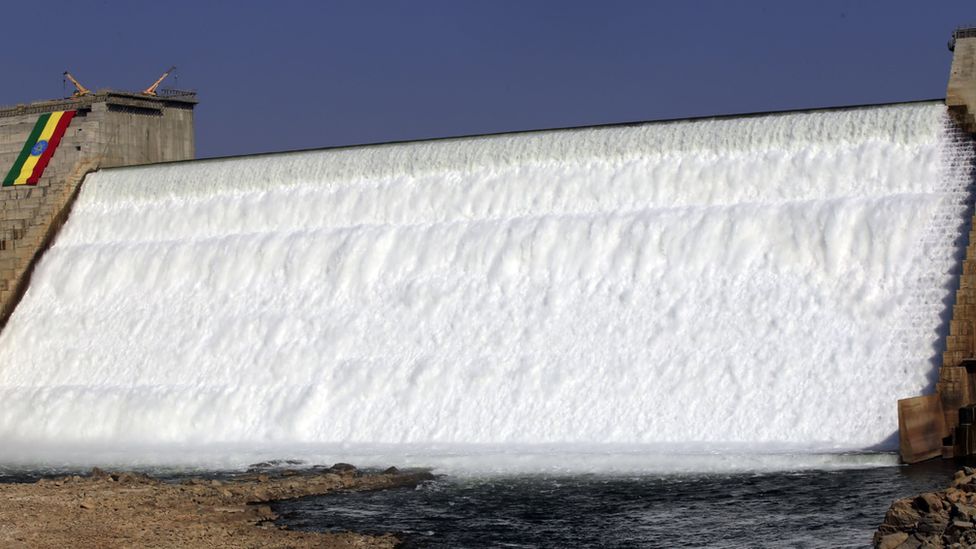Egypt has accused Ethiopia of threatening its supply of water from the River Nile.
It follows Ethiopia’s announcement that it has finished filling the reservoir at a giant new dam.
What is Ethiopia’s giant dam project?
The Grand Ethiopian Renaissance Dam (Gerd) is on the Blue Nile tributary in the northern Ethiopia highlands, from where 85% of the Nile’s waters flow.
Gerd is 19 miles (30km) south of the border with Sudan and is Africa’s biggest hydroelectric dam project. It is more than a mile long and 145m high.
- Egypt angry as Ethiopia fills Nile dam reservoir

It is not quite complete yet, but has already involved 12 years of construction.
The reservoir behind the $4.2bn (£3.8bn) dam has a surface area the size of Greater London.
How will the dam help Ethiopia?
Ethiopia wants the dam to produce electricity for the 60% of its population who currently go without it.
It is hoped it will eventually double Ethiopia’s electricity output, provide businesses with constant electricity supplies and boost development.
It could also provide electricity for neighbouring countries including Sudan, South Sudan, Kenya, Djibouti and Eritrea.
- Controversial Ethiopia dam starts generating power
Why are Egypt and Sudan upset about the dam?

Egypt, with a population of about 107 million people, relies on the River Nile for nearly all of its fresh water.
It needs it for households and agriculture – especially for growing cotton, which requires a lot of water.
Nile water is also used to fill Lake Nasser, the reservoir for Egypt’s own hydro-electric power plant, the Aswan High Dam.
Sudan, with a population of 48 million people, is also heavily reliant on water from the Nile.

Both countries are worried that the dam will allow Ethiopia to control the amount of water they receive.
Egypt is worried about whether Ethiopia will guarantee that enough water will flow downstream when there’s little rainfall, or whether they will continue to dam water to generate power.
“Ethiopia’s unilateral measures are considered a disregard for the interests and rights of the downstream countries and their water security,” its foreign ministry said.
It has argued that a 2% reduction in water from the Nile could result in the loss of 200,000 acres of irrigated land.
Low river levels could also affect transport on the Nile.
Ethiopia filled the dam over the course of only three years, saying that Egypt’s argument that it should take 12 to 21 years was unacceptable.
Although Sudan is as affected by water levels on the Nile as Egypt is, its response to the dam has been hampered by conflict in the country.
Can an agreement be reached over the dam?
The dam has been a source of disagreement between the countries since its construction began in 2011.
A treaty from 1929 (along with a treaty from 1959) gave Egypt and Sudan rights to almost all the Nile’s water.
It also gave them the right to veto projects by countries upstream (such as Ethiopia) that would deprive them of their share of water.
Ethiopia said it should not be bound by these old treaties, and it decided to start building the dam during the Arab Spring, when there was political turmoil in Egypt.
Egypt, Sudan and Ethiopia signed a new treaty in 2015, but talks over how Ethiopia uses Nile water to fill the dam have repeatedly broken down.
In 2019, the International Crisis Group – an organisation which works to prevent wars – warned that armed conflict was possible.
The US intervened in 2019, to try and reach an agreement between Egypt and Ethiopia, but with little success.
Talks only restarted three weeks before Ethiopia announced it had finished filling the dam.
